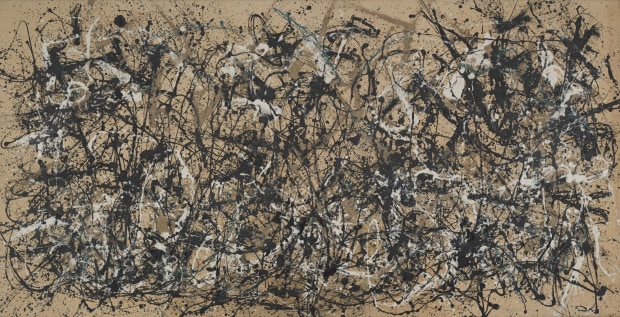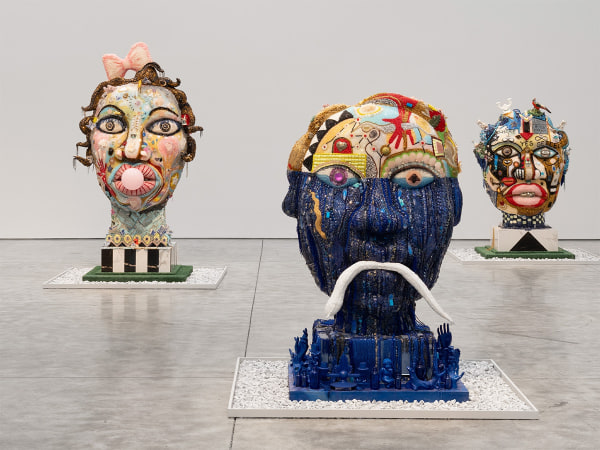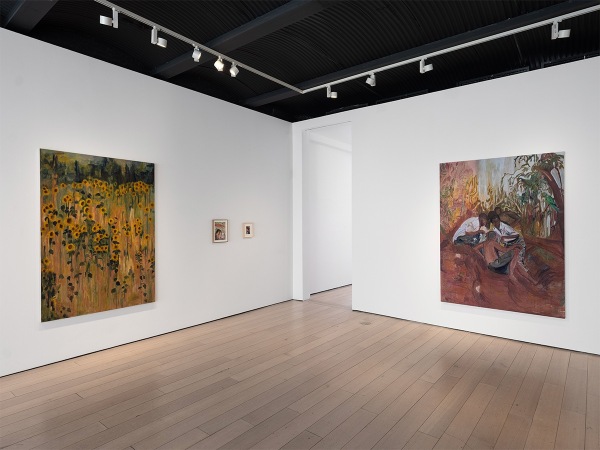Announcing Exclusive Global Representation of Jackson Pollock
-
Jackson Pollock in East Hampton, NY, 1953.
Photo: Tony Vaccaro. © Tony Vaccaro Archives -
“The gallery’s partnership with the Pollock-Krasner Foundation expands eight years after it began.”
—Hilarie M. Sheets, The Art Newspaper -
Kasmin announces exclusive global representation of the artwork of Jackson Pollock (1912–1956) through the Pollock-Krasner Foundation. Pollock was an Abstract Expressionist painter and defining figure of postwar American art, whose paintings and visionary techniques rank among the most recognizable and influential in the 20th century. In just under three decades, Pollock revolutionized the modes of art making for generations to come.
Read the exclusive feature by Hilarie M. Sheets in The Art Newspaper here.
Pollock’s representation marks an artistic reunion between his work and that of Lee Krasner (1908-1984), which Kasmin has represented through the Pollock-Krasner Foundation since 2016. This is the first time in a half century that these legendary American painters will share a gallery. Pollock joins the gallery’s roster alongside 20th-century artist estates and foundations including William N. Copley, JB Blunk, Max Ernst, Leonor Fini, Barry Flanagan, Jane Freilicher, Lee Krasner, Claude and François-Xavier Lalanne, Robert Motherwell, George Rickey, James Rosenquist, and Dorothea Tanning.
This October, the Musée National Picasso–Paris will mount Jackson Pollock: The Early Years, 1934–1947 (October 15, 2024–January 19, 2025). This major exhibition, the first of Pollock’s work in France since 2008, focuses on the diverse array of influences in the artist’s early career as reflected in over 100 works including loans from the Pollock-Krasner Foundation; Museum of Modern Art, New York; Metropolitan Museum of Art, New York; Centre Pompidou, Paris; Tate, United Kingdom and Stedelijk Museum Amsterdam. The exhibition will be accompanied by a fully-illustrated catalogue.
-
 Exterior of the Musée national Picasso-Paris. © Musée national Picasso-Paris, Voyez-Vous, Chloé Vollmer-Lo
Exterior of the Musée national Picasso-Paris. © Musée national Picasso-Paris, Voyez-Vous, Chloé Vollmer-LoAlso in October, Kasmin will present a selection of Pollock's early drawings from 1939–1943 at Frieze Masters in London to foreground a pivotal chapter in the artist’s career. Employing Surrealist techniques of automatic drawing, Pollock’s experimental works on paper reveal the psychological force driving his working method in the early 1940s and set the stage for the physiological drips that would define a major cultural breakthrough by the end of the decade. Pollock’s embrace of Carl Jung’s theories of the unconscious was at its strongest at this time, and his artistic output on paper documents a key technical transition in medium leading to a sophisticated mastery of the line. Rapid mark making in multicolored pencil and crayon become detailed linework and crosshatches in pen and ink, illustrating multiple images on a single support. Pollock’s imagery in these years reflects a myriad of formative influences, from Picasso to the Mexican Muralists and indigenous visual cultures. Pollock would soon cover entire surfaces to “veil the imagery,” in his words, giving way to powerful constellations that blur figure and ground as in his landmark painting Mural, commissioned by Peggy Guggenheim in 1943 and now held by the Stanley Museum of Art.
Eric Gleason, Head of Sales at Kasmin, says: "To unite Lee Krasner and Jackson Pollock under the same gallery roof once again, and to be able to further strengthen the mission of the Pollock-Krasner Foundation, is truly an honor. Jackson Pollock is the most iconic artist of the post-war era, and yet there are substantive elements of his life and oeuvre that remain thoroughly under-recognized. In the coming years, beginning with the revelatory exhibition set to open at the Musée National Picasso–Paris, Kasmin will work with the Foundation and a series of major institutions to develop exhibitions and scholarship that broaden our collective understanding of this titan of modern art."
-
"To unite Lee Krasner and Jackson Pollock under the same gallery roof once again, and to be able to further strengthen the mission of the Pollock-Krasner Foundation, is truly an honor. Jackson Pollock is the most iconic artist of the post-war era, and yet there are substantive elements of his life and oeuvre that remain thoroughly under-recognized."
—Eric Gleason, Head of Sales, Kasmin -




Ronald D. Spencer, Chairman & CEO of the Pollock-Krasner Foundation, said: "We are pleased to continue our collaboration with Kasmin through their representation of the works of Jackson Pollock. The significance of Jackson Pollock's contributions to the art historical canon cannot be overstated, and we look forward to Kasmin's support in continuing to share his legacy with the world—in concert with our collective championing of the work and legacy of Lee Krasner."
Nicholas Olney, President at Kasmin, says: "Kasmin's representation of the work of Jackson Pollock through the Pollock-Krasner Foundation marks a keystone moment in the gallery's history, exemplifying our commitment to rigorous artistic and intellectual inquiry. The forthcoming presentations of Pollock's work offer a profound window into the artist's early psyche as he processed the unconscious imagery that would go on to drive one of the greatest creative breakthroughs of the 20th century."
-
Pollock’s work can be found in world-renowned collections including The Museum of Modern Art, New York; Metropolitan Museum of Art, New York; Solomon R. Guggenheim Museum of Art, New York; Whitney Museum of American Art, New York; Art Institute of Chicago; Dallas Museum of Art; Glenstone, Potomac, MD; Hirshhorn Museum and Sculpture Garden, Washington, DC; Los Angeles County Museum of Art; National Gallery of Art, Washington, DC; Philadelphia Museum of Art; Smithsonian American Art Museum, Washington, DC; Stanley Museum of Art, Iowa City, IA; Artizon Museum, Tokyo, Japan; Centre Pompidou, Paris; Fondation Beyeler, Basel; Museum Ludwig, Cologne; National Gallery of Art, Canberra, Australia; Peggy Guggenheim Collection, Venice; Stedelijk Museum Amsterdam; Tate, London, and many others.
-
About the Artist

Jackson Pollock
Born in Wyoming and raised in Arizona and California, Jackson Pollock arrived in New York in 1930 and studied with muralist Thomas Hart Benton at the Art Students League before working for the WPA Federal Arts Project and in David Alfaro Siqueiros’ workshop over the next decade. In 1945, two years after his first solo exhibition, Pollock married artist Lee Krasner and moved to Springs, NY, where he made many of his landmark paintings on the floor of his barn studio. With crucial support from Krasner, gallerist and collector Peggy Guggenheim, influential critic Clement Greenberg, and others, Pollock’s international recognition would rise to an unprecedented height for an American artist by the 1950s, despite his struggle with alcoholism. After Pollock’s unexpected death in a car accident in 1956, Krasner would continue to champion his art, facilitating major exhibitions and acquisitions of his work.
Among the first Americans to be considered on the same tier as the European modern masters, Pollock paved the way for wider institutional recognition for his Abstract Expressionist contemporaries and his legacy stretches the globe. The work and writing of the next generation of artists, including Allan Kaprow, Donald Judd and the Gutai group in Japan, cemented his wider influence and placed him amid the most influential artists of the 20th century.
-
About the Pollock-Krasner Foundation
 Jackson Pollock and Lee Krasner in Pollock's studio, East Hampton, 1950. Photograph by Rudolph Burckhardt. © Estate of Rudolph Burckhardt, courtesy Pollock-Krasner House and Study Center, East Hampton, NY.
Jackson Pollock and Lee Krasner in Pollock's studio, East Hampton, 1950. Photograph by Rudolph Burckhardt. © Estate of Rudolph Burckhardt, courtesy Pollock-Krasner House and Study Center, East Hampton, NY.Pollock-Krasner Foundation
For nearly four decades, the Pollock-Krasner Foundation has supported working artists and cultural organizations internationally. Established in 1985 through the generosity of Lee Krasner, one of the foremost abstract expressionist painters of the 20th century, the Foundation is a leader in providing resources to emerging and established artists. To date, the Foundation has awarded more than 5,100 grants totaling over $90 million in 80 countries. Visit pkf.org to learn more about the Pollock-Krasner Foundation.
-
Join our Newsletter
* denotes required fields
We will process the personal data you have supplied in accordance with our privacy policy (available on request). You can unsubscribe or change your preferences at any time by clicking the link in our emails.
-
Explore
-
 Exhibitions
Exhibitionsvanessa german: GUMBALL—there is absolutely no space between body and soul
April 3 – May 10, 2025 509 West 27th Street, New York, 514 West 28th Street, New YorkKasmin presents its second solo exhibition of new work by artist vanessa german (b. 1976), which debuts related bodies of sculpture across two of the gallery’s spaces in New York. GUMBALL—there is absolutely no space between body and soul deepens german’s singular approach to sculpture as a spiritual practice with the power to transform lived experience. Both series comprise mineral crystals, beads, porcelain, wood, paint and the energy that these objects bring to life to form monumental heads and figures in the act of falling. Together, each body of work envisions the transformation of consciousness necessary to imagine a new world. -
 Exhibitions
ExhibitionsHelena Foster: Time Honoured
April 3 – May 3, 2025 297 Tenth Avenue, New YorkThe first New York solo exhibition of London-based painter Helena Foster features new oil paintings on linen, paper, and vellum that express the artist’s lyrical approach to painting as an accumulation of cultural and generational wisdom. Foster draws freely from literature, theater, film, Igbo oral tradition, and religion, achieving a dreamlike aura of mystery in dynamic compositions ambiguously set between thick vegetation and the built environment.
-
-
Explore
- Diana Al-Hadid
- Alma Allen
- Theodora Allen
- Sara Anstis
- Ali Banisadr
- Tina Barney
- Judith Bernstein
- JB Blunk
- Mattia Bonetti
- William N. Copley
- Cynthia Daignault
- Ian Davenport
- Max Ernst
- Liam Everett
- Leonor Fini
- Barry Flanagan
- Walton Ford
- Jane Freilicher
- vanessa german
- Daniel Gordon
- Alexander Harrison
- Elliott Hundley
- Robert Indiana
- Lee Krasner
- Les Lalanne
- Matvey Levenstein
- Lyn Liu
- Robert Motherwell
- Jamie Nares
- Nengi Omuku
- Robert Polidori
- Jackson Pollock
- Elliott Puckette
- Alexis Ralaivao
- George Rickey
- James Rosenquist
- Mark Ryden
- Jan-Ole Schiemann
- Joel Shapiro
- Bosco Sodi
- Dorothea Tanning
- Naama Tsabar
- Bernar Venet
Kasmin Sculpture Garden
New York
On view from The High Line at 27th Street
Monday–Sunday, 7am-11pm
+1 212 563 4474
info@kasmingallery.com
This website uses cookies
This site uses cookies to help make it more useful to you. Please contact us to find out more about our Cookie Policy.









